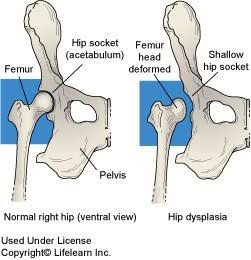Hip dysplasia is an abnormal or faulty development of the hip. A key sign is hip joint laxity, or a loose fit of the head of the femur in the hip socket. This looseness results in abnormal pressures being put on the sides and rim of the hip socket, leading to joint deformation and ultimately hip arthritis.

The two standardized diagnostic x-ray methods for hip dysplasia are:
- OFA Hip Score
- PennHip Method
OFA Hip Score
The OFA (Orthopedic Foundation for Animals) x-ray method is a single extended hip view that assesses the current state of the hip joint. Dogs are assigned a “hip score”.
The OFA classifies hips into one of seven different “hip scores” from excellent to severely dysplastic.
OFA Hip Dysplasia Top 10 Breeds
Below is a table of the 10 breeds with the highest percentage of dysplastic hips using the OFA method (source: OFA Breed Statistics). Note: These statistics only look at the prevalence, not severity.
| Breed | Evaluations | Dysplastic | |
| 1 | BULLDOG | 1,005 | 71% |
| 2 | PUG | 784 | 71% |
| 3 | OLDE ENGLISH BULLDOGGE | 114 | 66% |
| 4 | DOGUE DE BORDEAUX | 666 | 58% |
| 5 | NEAPOLITAN MASTIFF | 214 | 51% |
| 6 | BRUSSELS GRIFFON | 122 | 49% |
| 7 | ST. BERNARD | 2,470 | 49% |
| 8 | OTTERHOUND | 507 | 48.5% |
| 9 | CLUMBER SPANIEL | 1,139 | 44% |
| 10 | BLACK RUSSIAN TERRIER | 863 | 41% |
In the context of all of the OFA evaluations, it’s my opinion that the top 10 breeds are somewhat skewed. Several of these breeds have less than 500 evaluations. An assumption could be that there was a strong suspicion of hip dysplasia on physical examination, that lead to an OFA x-ray being completed. The hip dysplasia diagnosis being confirmed by x-rays.
The following table includes the top 10 breeds with more than 5,000 evaluations. Also included are a few notable mentions.
| Breed | Evaluations | Dysplastic | ||
| 1 | 25 | NEWFOUNDLAND | 17,605 | 26% |
| 2 | 26 | BULLMASTIFF | 6,534 | 26% |
| 3 | 33 | ROTTWEILER | 101,127 | 21% |
| 4 | 35 | CHOW CHOW | 5,884 | 21% |
| 5 | 37 | MASTIFF | 12,532 | 21% |
| 6 | 38 | GERMAN SHEPHERD DOG | 125,422 | 20.5% |
| 7 | 40 | PEMBROKE WELSH CORGI | 13,473 | 20% |
| 8 | 41 | GOLDEN RETRIEVER | 156,506 | 20% |
| 9 | 42 | CHESAPEAKE BAY RETRIEVER | 14,619 | 20% |
| 10 | 44 | OLD ENGLISH SHEEPDOG | 11,658 | 19% |
| 75 | BRITTANY | 20,809 | 14% | |
| 96 | LABRADOR RETRIEVER | 270,112 | 12% | |
| 98 | POODLE | 29,664 | 12% | |
| 112 | BORDER COLLIE | 14,801 | 10.5% | |
| 147 | AUSTRALIAN SHEPHERD | 39,391 | 6% | |
| 158 | SHETLAND SHEEPDOG | 23,548 | 5% |
The higher evaluation numbers in these breeds likely provide a more accurate sample of hip dysplasia predisposition with in the individual breeds.
PennHip Method
The PennHIP method is considered the most accurate x-ray method for detecting hip dysplasia and laxity in young puppies (from 16 weeks of age). It can accurately predict whether a puppy will develop hip arthritis later in life.
On the PennHip evaluation, a higher distraction index indicates greater hip laxity and an increased risk of developing hip dysplasia with arthritis. There is a low risk of developing hip dysplasia with arthritis when the distraction index is close to 0.30.
PennHip Distraction Index Top 10
Below is a table of the 10 breeds with the highest PennHip Distraction Index. Also included are some breeds that featured highly on the OFA hip scores.
| Breed | Distraction Index | |
| 1 | CLUMBER SPANIEL | 0.72 |
| 2 | BASSET HOUND | 0.71 |
| 3 | ENGLISH FOXHOUND | 0.71 |
| 4 | FRENCH BULLDOG | 0.71 |
| 5 | CHOW CHOW | 0.69 |
| 6 | ENGLISH BULLDOG | 0.69 |
| 7 | COTON DE TULEAR | 0.68 |
| 8 | FIELD SPANIEL | 0.68 |
| 9 | DOGUE DE BORDEAUX | 0.67 |
| 10 | PEMBROKE WELSH CORGI | 0.66 |
| NEWFOUNDLAND | 0.58 | |
| NEAPOLITAN MASTIFF | 0.66 | |
| ROTTWEILER | 0.55 | |
| GERMAN SHEPHERD DOG | 0.43 | |
| GOLDEN RETRIEVER | 0.55 | |
| LABRADOR RETRIEVER | 0.49 | |
| BORDER COLLIE | 0.48 | |
| AUSTRALIAN SHEPHERD | 0.47 |
Conclusion
While the top 10 breeds differ between the PennHip and OFA methods, there are definitely consistencies. If your dog breed is predisposed to hip dysplasia, talk to your Vet about screening their hips using either the OFA Hip Score or PennHip method.
If you’re considering breeds predisposed to hip dysplasia as an addition to your family, talk to potential breeders about the genetic lines in their breeding dogs. They should know their breeding lines and be able to confirm that they have clear hips (and other genetic disorders common to the breed). Your Vet will also be able to help you with questions if you’re unsure.
Click here if you would like to read more about hip dysplasia diagnosis, treatment, home strategies, and more.

